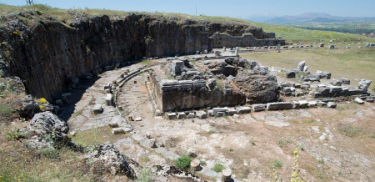Seleucus I Nicator (one of Alexander the Great's generals and the founder of the Seleucid Dynasty of rule) ruled Antioch sometime after 323 B.C.
In 189, after the peace with Antiochus the Great, the Romans made Antioch a free city. The Romans took over total control of the city in 25 B.C. Antioch was made a colony of the Romans under Emperor Augustus around 6 B.C. It became a military colony and a center of civil administration centers in the region.
Mark Leaves the Team
It is just before Paul visits Pisidian Antioch during his first missionary journey that fellow evangelist and gospel writer John Mark abruptly decides (for reasons not delineated in the Bible) to return to Jerusalem (Acts 13:13). His departure will later become a catalyst for Paul and Barnabas splitting up before the apostle's second missionary journey.

Now Paul and Barnabas were staying in (Syrian) Antioch with many others, teaching and preaching the gospel - the Word of the Lord. And after certain days, Paul said to Barnabas, "Let us go back to see how our brethren are doing in every city where we have preached the Word of the Lord."
And Barnabas was determined to take with them John who was called Mark (John Mark and Barnabas were cousins); But Paul did not think it good to take him because he had departed from them at Pamphylia, and did not go with them to the work.
As a result, such a sharp contention arose between them that they parted from one another. And Barnabas took Mark and sailed to Cyprus; But Paul chose Silas and departed, after being committed to the grace of God by the brethren (Acts 15:35 - 40, HBFV).
Meeting Timothy
It was during his second missionary journey, just before visiting Antioch, that Paul met a new traveling companion named Timothy. Raised in a Bible-believing family (2Timothy 1:5) Timothy would become a valuable aid in spreading the gospel and eventually become Paul's most trusted friend. He would be with the apostle Paul until the very end when he was martyred by the Romans.
Antioch and its environs, in Paul's day, was notorious for its many robbers. This may have been one of the places Paul alludes to when he lists, in the book of 2Corinthians, some of the trials and troubles he experienced while preaching.
Are they servants of Christ? (I am speaking as if I were out of my mind.) So am I, above and beyond measure - in labors more abundant, in stripes above measure, in imprisonments more frequent, in deaths often . . . I have been in journeyings often, in perils of rivers, IN PERILS OF ROBBERS . . . (2Corinthians 11:23, 26).
Paul, at the time he wrote 2Corinthians (in 57 A.D.), had already experienced a great deal of trials and suffering. He had been beaten by Jewish authorities at least five times, beaten by others with rods three other times, and stoned to death outside Lystra (2Corinthians 11:24 - 25, Acts 14:19 - 20). He ultimately visited Antioch at least three times during his ministry, during his first, second and third missionary journeys.